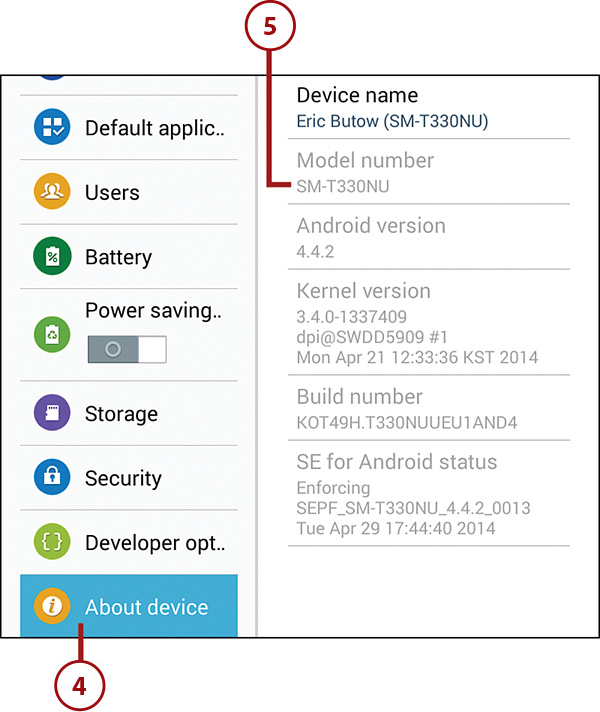18. Troubleshooting Your Galaxy Tab 4
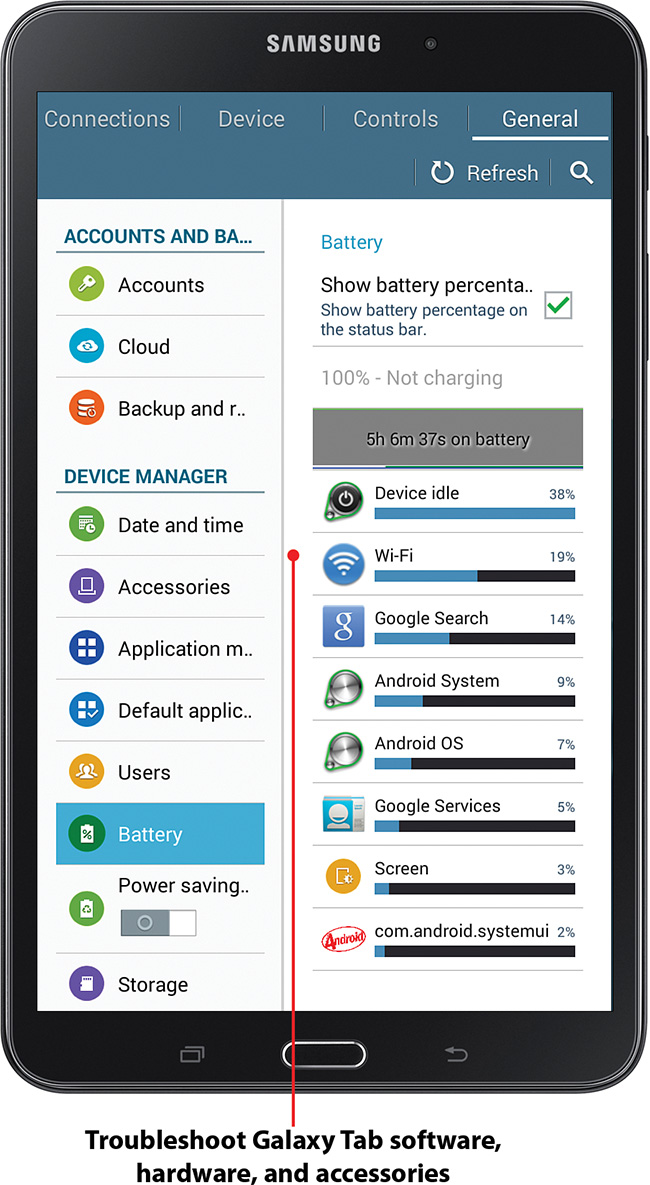
This chapter covers ways that you can properly maintain your Galaxy Tab 4 and troubleshoot basic software or hardware problems. Topics covered in this chapter include:
![]() Updating the Galaxy Tab software
Updating the Galaxy Tab software
![]() Backing up and restoring your Galaxy Tab 4
Backing up and restoring your Galaxy Tab 4
![]() Troubleshooting connected devices
Troubleshooting connected devices
![]() Getting help
Getting help
Although problems concerning the Galaxy Tab 4 software, hardware, and accessories are rare, on occasion you might experience incidents where your Tab does not perform properly. There are a few fixes you can try if you experience the occasional glitch that can occur with any hardware device.
Although your Galaxy Tab 4 is a sophisticated piece of hardware, it is less complex than an actual computer, making any issue that might arise more manageable.
Maintaining Your Galaxy Tab 4
Regular maintenance of your Galaxy Tab 4 not only helps extend the life of your Tab, it also helps ensure peak performance. It’s important that you make sure your Galaxy Tab 4 software is up to date and understand basic troubleshooting concepts. Properly cleaning and protecting your Tab’s body can be equally important. The Galaxy Tab was designed to be sturdy, but, like any other electronic device, it can collect dust, and a simple drop on the sidewalk can prove disastrous. The first step in maintaining your Galaxy Tab is prevention. You can start by purchasing a protective case.
A sturdy case designed for the Galaxy Tab 4 is important for the overall protection of your device. A number of companies have created a variety of cases for the Tab, so search the Internet or go to Amazon.com to see what’s out there. The more padded the case, the better it can absorb a shock if you happen to drop your Tab. A case can also help protect your Tab from dust and keep it dry if you happen to get caught in the rain. Make sure that you keep the inside of your case clean. Dust and sand can find its way into even the most well-constructed cases. Instead of using your sleeve to wipe off your Galaxy Tab’s display, invest in a microfiber cloth; you can find them in any office supply or computer store.
Your first instinct might be to wet a cloth to clean your Galaxy Tab touchscreen. Don’t use liquids to clean the touchscreen, especially if they include alcohol or ammonia. These harsh chemicals can cause irreparable damage to the touchscreen, rendering it difficult to see. Consider purchasing a screen protector at a local store or your favorite online retailer to keep the touchscreen dust and scratch free. Some screen protectors also come with a microfiber cleaning cloth.
Updating Galaxy Tab 4 Software
Every so often, Google releases software updates for your Galaxy Tab’s Android operating system. To get the most from your Galaxy Tab 4, it is good practice to update soon after an upgrade has been released. When an update is available, you receive a notification that indicates that you can download a system upgrade. At that point, you have the option to initiate the software update. You can also check for system updates manually by tapping Settings in the Apps screen, tapping General in the menu bar at the top of the screen, tapping About Device in the Settings list, and then choosing Software Update. You are given an option to Check for Updates. If your system is up to date, your Tab alerts you to this fact. If an update is available, follow the provided directions to upgrade your software.
The Android operating system is not the only software you need to update on your Galaxy Tab. Your Tab also uses software, called firmware, to run its internal functions. When an update is available, use your own discretion as to whether you want to update right away, just in case there are any issues with the update.
Backing Up and Restoring Your Galaxy Tab 4
Backing up the contents of your Galaxy Tab 4 is a good practice for securing your important information and multimedia content. You can ensure that your contacts, photos, videos, and apps are copied to your PC or Mac in case something happens to your Tab.
Ensure Automatic Google Account Backup
Your Google account information—such as your Gmail inbox, Contacts list, and Calendar app appointments—automatically sync with Google servers, so this information is already backed up for you. To ensure that your Google account information is being automatically backed up, follow these directions.
1. Tap the Apps icon on the Home screen.

2. Tap Settings on the Apps screen.

3. Tap General in the menu bar.
4. Tap Google in the list.
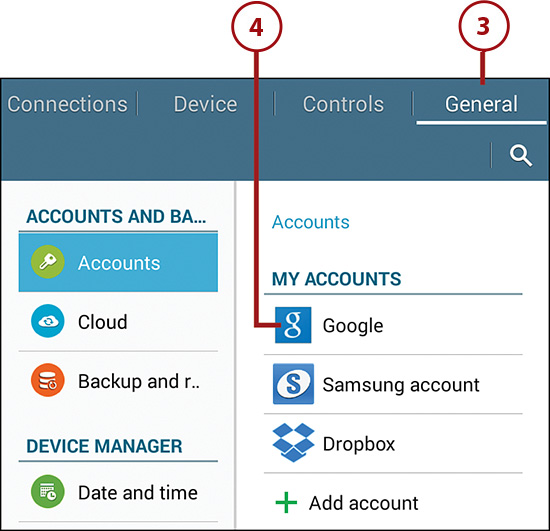
5. Tap the Google email account in the list of accounts.
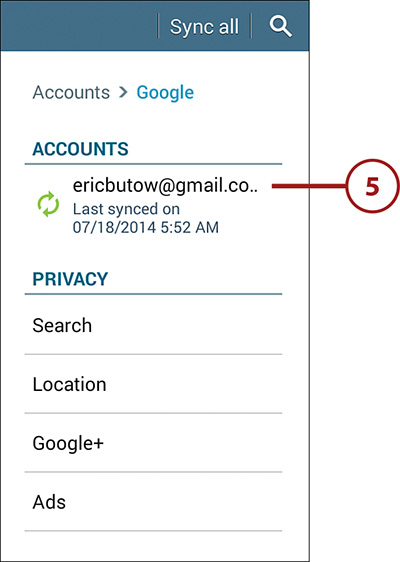
6. Ensure that all the account settings in the list have a green check mark to the right. If they don’t, tap the box to place a green check mark within the box.
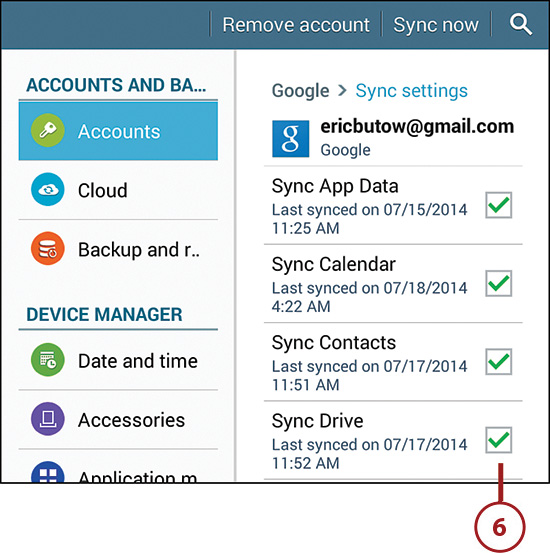
7. Tap Backup and Reset.
8. Ensure that a green check mark appears next to Back Up My Data and Automatic Restore. If not, tap the box in each field to place a green check mark within the box. The information associated with your Google address is now automatically backed up.
9. Tap Backup Account to immediately begin backing up your Google account data.
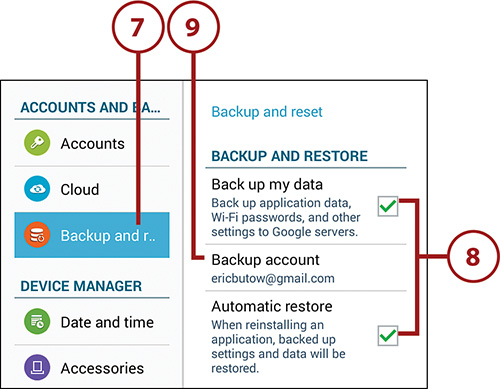
Syncing and Using Manual Backup
There are multiple ways for you to back up content that is outside of your Google account information on your Galaxy Tab 4, such as your apps and multimedia content, onto your computer. Connect your Galaxy Tab 4 to your PC as a mass storage device and manually drag and drop files. You can use the Samsung Kies software to transfer data, synchronize files, and update firmware while connected to a PC or Mac.
When connected to your PC as a mass storage device, you can view all of the data on your Tab’s internal storage and optional MicroSD card. The content is categorized into specific folders that you can copy from your card and internal storage such as DCIM, Download, Music, Pictures, Movies, Podcasts, and more. You can also copy all folders with the names of apps installed on your Galaxy Tab 4.
You can also use the Samsung Kies software for PCs and Macs to sync your content. See Chapter 12, “Playing Music and Video,” to learn how to exchange content between your Galaxy Tab 4 and your computer by connecting as a mass storage device and by using Samsung Kies.
Extending Battery Life
Your Galaxy Tab 4 is capable of up to at least 7.5 hours of battery life depending on the model you have. Battery life can also vary depending on how you use the Galaxy Tab. Strenuous tasks, such as playing HD video, dramatically lower your battery life more than surfing the Web does. You can monitor your battery power at the top of the screen in the Status area. The green battery status icon located in the lower right of the Status Bar lets you keep an eye on how much battery power you have left. When the battery gets low, a warning appears, informing you of the percentage of battery power you have left and instructing you to connect the charger. When the battery is too low, your Tab automatically shuts down. There are a few things you can do to extend the life of your Tab’s battery.
Monitor Power Usage
On the Galaxy Tab 4 you can use the Battery Usage screen to see which of the apps you use consumes the most power, and then you can reduce the use of those apps. Your battery power savings are small, but if you’re running low on power with no way to recharge, every little bit counts. Follow these directions to access the Battery Usage screen.
1. Tap the Apps icon on the Home screen.

2. Tap Settings on the Apps screen.
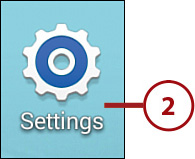
3. Scroll down the Settings list (if necessary) and then tap Battery. The screen displays the items that are consuming the most battery power. In this example, 19 percent of the battery power has been used for the Wi-Fi hardware to communicate with the Internet.
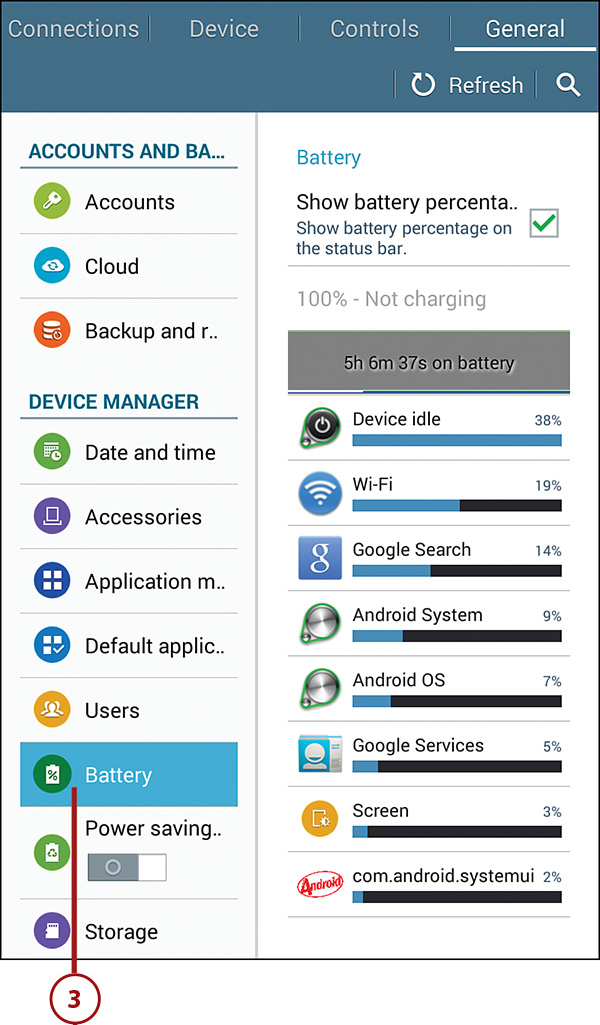
Adjust Screen Brightness
The high-quality touchscreen of the Galaxy Tab 4 can consume plenty of battery power. The higher the brightness level set on your Galaxy Tab 4 the more power the touchscreen uses. If you are viewing the screen in very bright conditions, you probably do not need a very high brightness setting. Consider dimming the screen to extend the battery life.
1. Tap the Apps icon on the Home screen.

2. Tap Settings on the Apps screen.
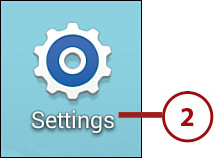
3. Tap Device in the menu bar.
4. Tap Display.
5. Tap Brightness.
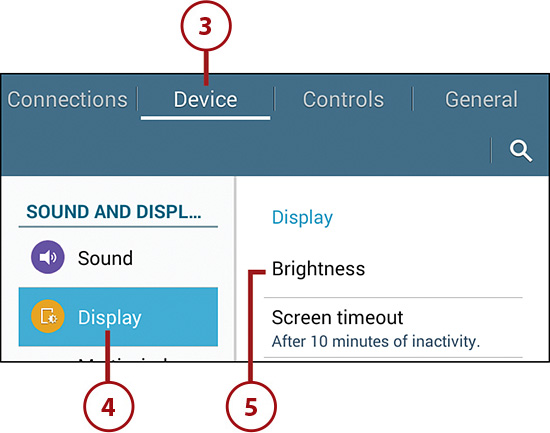
6. Slide the slider to the left to lower the brightness level or to the right to increase the brightness level.
7. Tap OK.

Utilize Sleep Mode
Your Galaxy Tab 4 goes to sleep after a specified period of inactivity, but you don’t have to wait for it to fall asleep; you can put it to sleep manually. When your Tab is awake, it is consuming battery power. Press the sleep button on the side of your Tab when you have finished using the device to conserve battery power.
Conserve Power by Turning Off Wi-Fi
When the Wi-Fi antenna is activated on your Galaxy Tab, your device is incessantly looking for available Wi-Fi networks to join, which uses battery power. To see if Wi-Fi is turned on, check the Status Bar in the top-left corner of your Galaxy Tab for the Wi-Fi symbol. If you do not need a Wi-Fi connection, turn it off to conserve battery power. If you are not wandering and are using Wi-Fi in a single location, look for a power outlet and plug in your Tab.
1. Tap the Apps icon on the Home screen.

2. Tap Settings on the Apps screen.
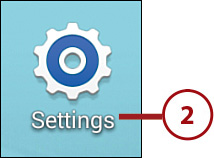
3. Tap Wi-Fi to view Wi-Fi networks available to you.
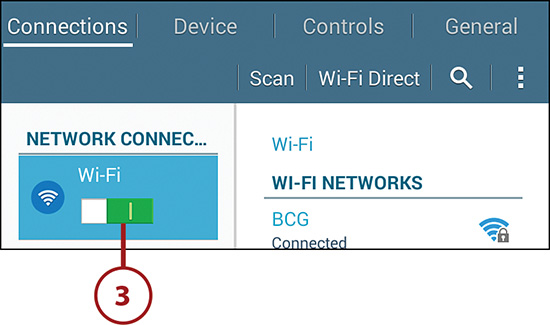
4. Turn off Wi-Fi by sliding the Wi-Fi slider to the left. The slider button displays an O (for Off) with a gray background, and the right side of the screen asks you to turn on Wi-Fi to see available networks.
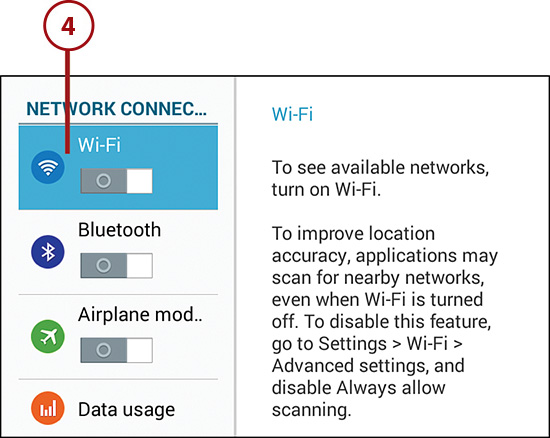
Conserve Power by Turning Off Bluetooth
When Bluetooth is activated on your Galaxy Tab, your device is constantly checking for other Bluetooth devices, which drains battery power. To see if Bluetooth is turned on, check the Status Bar in the top-left corner of your Galaxy Tab for the Bluetooth symbol. If you are not using a Bluetooth device, turn this function off. There are also security reasons why you should turn off Bluetooth when you are not using it, so get in the habit of turning Bluetooth off as soon as you finish using a wireless device with your Galaxy Tab. You can easily deactivate Bluetooth in the Notifications panel.
1. Tap the Apps icon on the Home screen.

2. Tap Settings on the Apps screen.
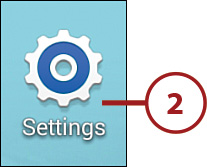
3. View all Bluetooth devices to which the Galaxy Tab 4 is connected by tapping Bluetooth.
4. Turn off Bluetooth by sliding the Bluetooth slider to the left. The slider button displays an O (for Off) with a gray background, and the right side of the screen asks you to turn on Bluetooth to see available devices.

Solving Random Galaxy Tab Issues
The occasional hardware or software glitch happens to even the best of electronic devices. You might encounter an issue, although rare, where an app you are using freezes, a wireless device proves difficult to pair with your Galaxy Tab 4, the touchscreen becomes unresponsive, or landscape orientation is not available at all times. Fortunately, it is not very difficult to troubleshoot some of these issues. If you should happen to come across a problem that you can’t solve yourself, there are plenty of channels for you to find technical support.
Difficulty Turning Your Tab On or Off
On rare occasions, you might find that your Galaxy Tab 4 is stubborn when you try to turn it on or off. It might appear that the device has locked or become unresponsive. If this happens to you, hold the Power button for 8 seconds to see if the Tab 4 responds. If this does not work, you might need to let your Tab sit for a few seconds before you again try holding the Power button for 8 seconds.
Touchscreen Becomes Unresponsive
This tip assumes that your Galaxy Tab 4 and any app you are using is responsive, but the touchscreen is not responding to your touch. If you attempt to use your Galaxy Tab 4 touchscreen while wearing conventional gloves, it does not work. This can prove inconvenient on a very cold day, so you might want to consider a capacitive stylus for your Galaxy Tab.
Your Tab uses a capacitive touchscreen that holds an electrical charge. When you touch the screen with your bare finger, capacitive stylus, or special static-carrying gloves, it changes the amount of charge at the specific point of contact. In a nutshell, this is how the touchscreen interprets your taps, drags, and pinches.
The touchscreen might also be unresponsive to your touch if you happen to have a thin coat of film on your fingertips. So no sticky fingers, please.
Force Stop an App
Sometimes an app might get an attitude and become unruly. For example, an app might provide a warning screen saying that it is currently busy and is unresponsive, or it might give some other issue warning to convey that a problem exists. If an app is giving you problems, you can manually stop the app.
1. Tap the Apps icon on the Home screen.

2. Tap Settings on the Apps screen.
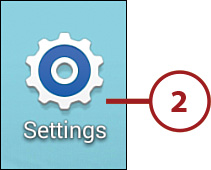
3. Scroll down the Settings list (if necessary) and then tap Application Manager.
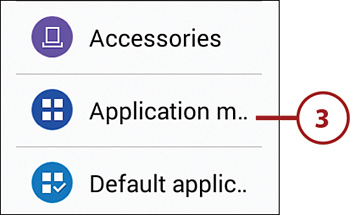
4. In the heading area above the list of apps, swipe right to left until you see the Running header. The Running list appears under the Running header and shows only the apps that are currently running.
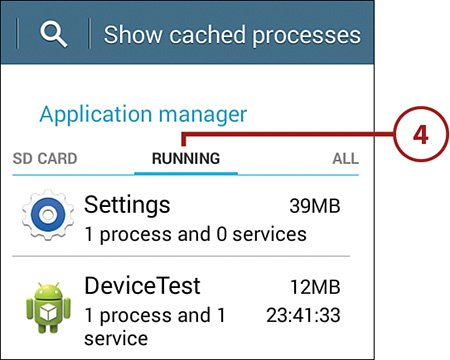
5. Swipe down the list of apps if necessary and then tap the problem app.
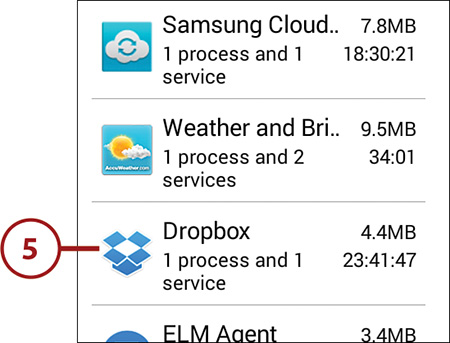
6. Tap Stop. The app stops running.
7. Tap Report to send a problem report to the app’s developer.
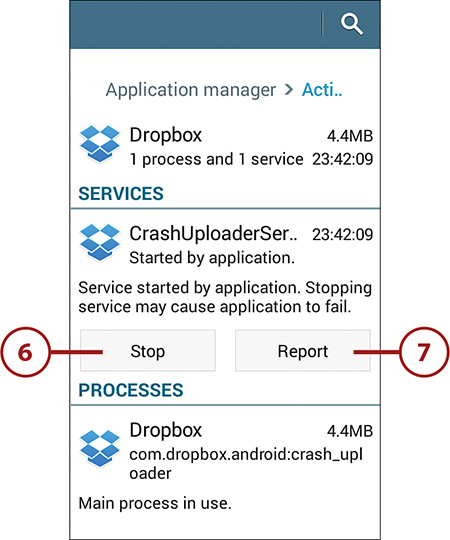
Battery Does Not Charge
If you find that your battery is not charging, first start with the power outlet. Is the outlet supplying power? Is the power strip turned on? Plug something else into the outlet to see if it works, or try another outlet.
Make sure that everything is connected properly. Is the adapter secure on both ends? If the outlet supplies power and the cables are connected properly, but the battery still does not charge, try another cable. If this does not solve the issue, your battery might be defective. Contact Samsung technical support. (See the “Getting Technical Help” section later in this chapter for more information about how to contact Samsung.) There is no way for you to remove the battery yourself.
Landscape Orientation Does Not Work
The orientation setting on your Galaxy Tab 4 could be set so that your Tab stays in either portrait or landscape mode, regardless of how you hold the device. If your Tab no longer utilizes landscape orientation, first check the setting for screen orientation.
The Galaxy Tab 4 has an Auto-Rotate setting that must be selected for the screen to adjust from portrait to landscape mode, depending on how you hold the device. You can easily confirm that the Auto-Rotate setting is selected from the Settings menu.
1. Open the Quick Settings and Notifications screen from the Home screen by tapping and holding on the top edge of the screen and then swiping downward.
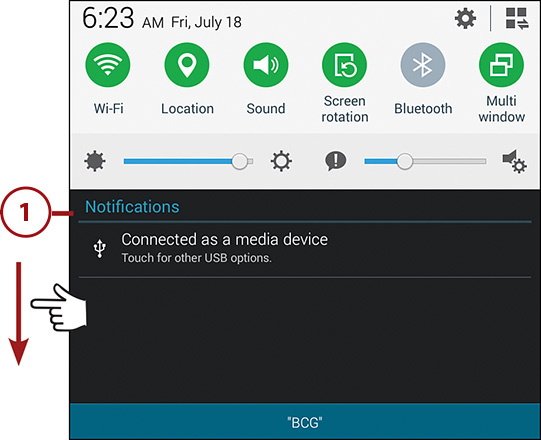
2. Locate the Screen Rotation setting button and confirm that the button above the Screen Rotation text is green. If the icon is gray, activate the setting by tapping the button. Your Galaxy Tab screen should now adjust to the orientation in which you hold the device.
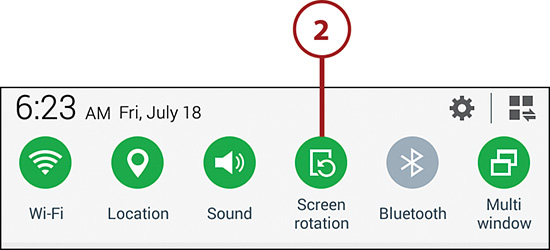
Troubleshooting Wi-Fi Accessibility Problems
Your Galaxy Tab 4 provides you the convenience and flexibility of wireless Internet access via Wi-Fi connectivity. Along with this convenience and flexibility comes the potential for connectivity issues regarding wireless networks. If you are unable to access a Wi-Fi network, or if your connection is sporadic, there are some troubleshooting tips you can use to pinpoint basic accessibility options.
Make Sure Wi-Fi Is Activated
First and foremost, make sure that the Wi-Fi antenna is on. You can determine this by looking in the right corner of the system bar at the top of your Galaxy Tab screen to see whether the Wi-Fi icon is visible. If it is not on, you can open the Quick Settings and Notifications screen and then activate Wi-Fi by tapping the Wi-Fi button.

Check Your Range
If Wi-Fi is activated on your Galaxy Tab 4 and you still cannot connect, take note of how far away you are from the Wi-Fi access point. You can be only 115 feet from a Wi-Fi access point before the signal becomes weak or drops altogether. Structures such as walls with lots of electronics can also impede a Wi-Fi signal. Make sure you are close to the access point or turn on the access point’s range booster, if it has one, to improve your connection.
Reset the Galaxy Tab 4 Software
If all else fails and your technical problems still persist, as a last ditch effort you might need to reset the Galaxy Tab software. Resetting your Galaxy Tab software restores your Tab to the factory defaults, just like when you took it out of the box for the first time. Consider contacting support before you reset your Tab, but if you must, follow these directions to reset the device.
1. Tap the Apps icon on the Home screen.

2. Tap Settings on the Apps screen.

3. Tap General in the menu bar.
4. Tap Backup and Reset.
5. Tap Factory Data Reset.
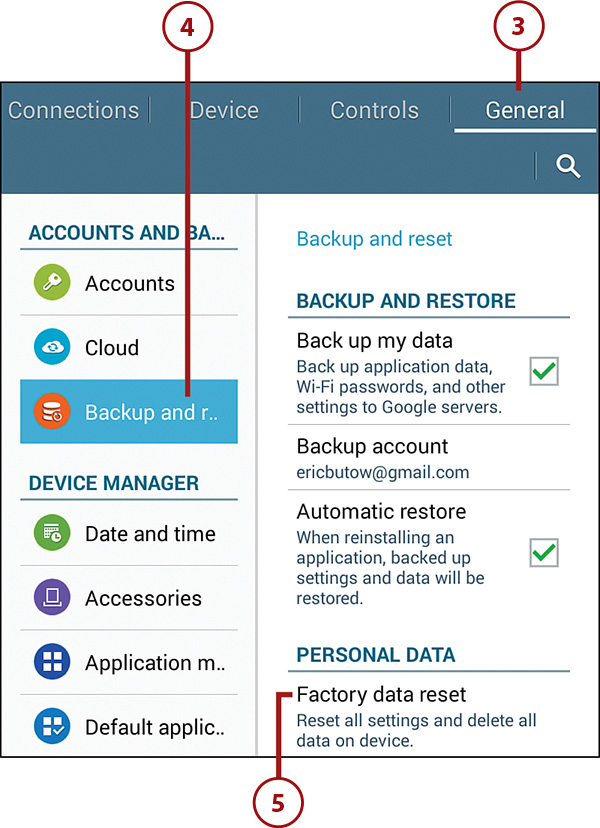
6. Tap the Reset Device button.

7. If you use a password to log into your Tab, type the password in the Confirm Password field.
8. Tap Continue.
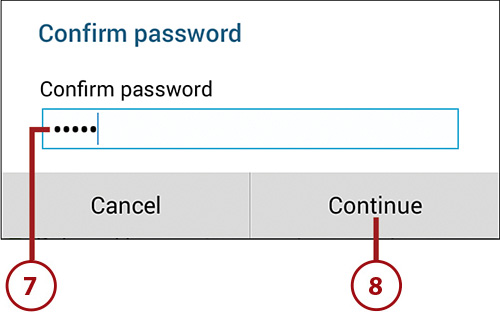
9. Tap the Delete All button to confirm. Your Tab is returned to its factory state.
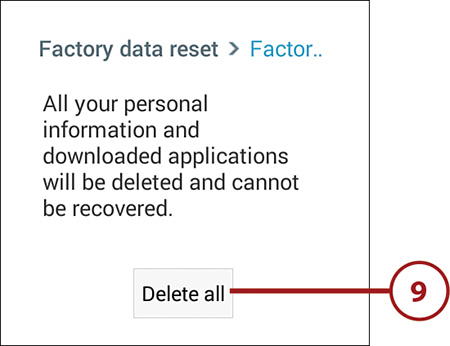
Getting Technical Help
There are many outlets available where you can find help if you run across a Galaxy Tab technical problem that you can’t seem to beat. Although limited, the user’s manual is a good place to start. You can download the correct manual for your Galaxy Tab model online from the Samsung website (www.samsung.com), in the form of a PDF, and scan the table of contents or perform searches in the document for words that pertain to your problem. In most user manual PDFs, topics in the Table of Contents are often linked to the section they pertain to within the document, so when you find what you are looking for, click the topic and jump to the page.
Websites and Galaxy Tab forums are also a great way for you to get support for your device. Type a search phrase, such as “Galaxy Tab Google Calendar sync problem,” into Google. Chances are there are plenty of people who are experiencing the same issue. Doing some online research of your own could save you a few minutes on the telephone with technical support and help you solve your problem more quickly.
Contact Your Cellular Provider or Samsung
The Samsung website is a great resource for getting help with technical issues with your Galaxy Tab 4. The Samsung website (www.samsung.com/us/support/) offers support via Twitter, Facebook, Google Plus, as well as by phone (1-800-726-7864). Before you call, you need to have your device’s model number so that you can give it to the technical support representative.
Locate Tab Model Number
You can find the model number on the box that your Tab shipped in, and you can also find it in the Settings menu.
1. Tap the Apps icon on the Home screen.

2. Tap Settings on the Apps screen.
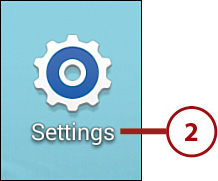
3. Tap General in the menu bar at the top of the screen.
4. Scroll down the Settings list and then tap About Device.
5. Locate your Tab’s model number in the About Device field on the right of the screen.
